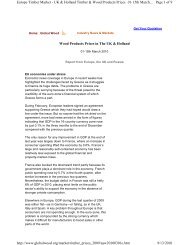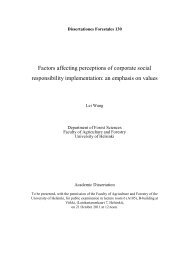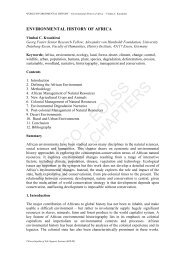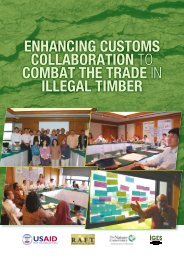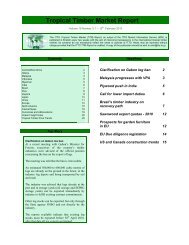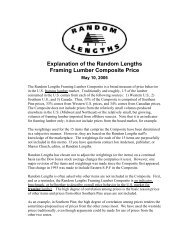ICT and e-Business in the Pulp, Paper and Paper ... - empirica
ICT and e-Business in the Pulp, Paper and Paper ... - empirica
ICT and e-Business in the Pulp, Paper and Paper ... - empirica
You also want an ePaper? Increase the reach of your titles
YUMPU automatically turns print PDFs into web optimized ePapers that Google loves.
<strong>Pulp</strong>, paper <strong>and</strong> paper products<br />
As regards <strong>the</strong> frequency b<strong>and</strong>s used to transmit data from tags, EPCglobal, <strong>the</strong> GS1<br />
subsidiary <strong>and</strong> driver of st<strong>and</strong>ards for <strong>the</strong> use of RFID <strong>in</strong> <strong>the</strong> supply cha<strong>in</strong>, is currently<br />
test<strong>in</strong>g which b<strong>and</strong>s are best suited for us<strong>in</strong>g RFID to identify <strong>and</strong> track <strong>in</strong>dividual items.<br />
High-frequency (HF) 13.56 MHz tags <strong>and</strong> ultrahigh-frequency (UHF) 915 MHz tags can<br />
be used. The former have a shorter read range, but tend to perform better on items that<br />
can cause <strong>in</strong>terference. 89<br />
Advantages over barcode technology<br />
From a functional perspective, RFID has several advantages over <strong>the</strong> older barcode<br />
technology. The ma<strong>in</strong> advantages which are relevant for <strong>the</strong> P&P <strong>in</strong>dustry are:<br />
RFID tags can store more <strong>in</strong>formation than a barcode. This <strong>in</strong>creases<br />
considerably opportunities <strong>and</strong> options for <strong>the</strong>ir use (while at <strong>the</strong> same time<br />
carry<strong>in</strong>g <strong>the</strong> risk of creat<strong>in</strong>g an overflow of less relevant data).<br />
Transmitt<strong>in</strong>g <strong>in</strong>formation from an RFID tag does not require l<strong>in</strong>e-of-sight with <strong>the</strong><br />
reader. Thus, manual processes (e.g. h<strong>and</strong> scann<strong>in</strong>g of barcode labels) can be<br />
partly of fully automated, as RFID readers can read <strong>in</strong>formation even from tags that<br />
are hidden or embedded <strong>in</strong> items.<br />
RFID systems allow for simultaneous identification. Systems are capable of<br />
process<strong>in</strong>g about 400 signals per second, <strong>in</strong>clud<strong>in</strong>g <strong>the</strong> identification of several<br />
tags at <strong>the</strong> same time. 90 Thus, <strong>in</strong>formation from several pallets or o<strong>the</strong>r units can<br />
be transmitted simultaneously, while scann<strong>in</strong>g barcodes can only be done <strong>in</strong> a<br />
sequential mode.<br />
However, while <strong>the</strong>se functional advantages are certa<strong>in</strong>ly an attractive proposition for <strong>the</strong><br />
future, RFID technology is still ra<strong>the</strong>r expensive when compared to barcode equivalents,<br />
ma<strong>in</strong>ly due to <strong>the</strong> implementation cost of <strong>the</strong> overall system (see Section 4.3.4).<br />
4.3.2 Adoption of RFID: commercial break-through among large firms<br />
e-<strong>Bus<strong>in</strong>ess</strong> W@tch asked companies questions about RFID <strong>in</strong> <strong>the</strong> e-<strong>Bus<strong>in</strong>ess</strong> Surveys of<br />
2005 <strong>and</strong> 2006. Results demonstrate <strong>the</strong> gap between expectations that a technology will<br />
be important <strong>and</strong> <strong>the</strong> actual usage of it. In 2005, companies represent<strong>in</strong>g about 40% of<br />
employment <strong>in</strong> <strong>the</strong> food <strong>and</strong> beverages <strong>and</strong> <strong>the</strong> automotive <strong>in</strong>dustries, <strong>and</strong> about 30% <strong>in</strong><br />
<strong>the</strong> textile <strong>in</strong>dustry said <strong>the</strong>y expected that RFID would be important for <strong>the</strong>m <strong>in</strong> <strong>the</strong><br />
future. In <strong>the</strong> pharmaceutical <strong>in</strong>dustry <strong>and</strong> <strong>in</strong> mach<strong>in</strong>ery <strong>and</strong> equipment, about 25% of<br />
firms regarded RFID as relevant. 91<br />
Based on this f<strong>in</strong>d<strong>in</strong>g, a new question was <strong>in</strong>troduced <strong>in</strong> 2006, ask<strong>in</strong>g companies whe<strong>the</strong>r<br />
<strong>the</strong>y actually use RFID, with a follow-up question for users about <strong>the</strong> purposes for which<br />
<strong>the</strong>y use this technology. The result may come as a surprise, consider<strong>in</strong>g <strong>the</strong> great<br />
expectations of firms <strong>and</strong> <strong>the</strong> enormous attention which RFID enjoys as an issue <strong>in</strong> <strong>the</strong><br />
89<br />
90<br />
91<br />
"EPCglobal Develop<strong>in</strong>g HF Tag St<strong>and</strong>ard", by Mary Ca<strong>the</strong>r<strong>in</strong>e O'Connor, published at<br />
www.rfidjournal.com, 8 May 2006.<br />
See e-commerce magaz<strong>in</strong>e, 02/2005, p. 48.<br />
See respective e-<strong>Bus<strong>in</strong>ess</strong> W@tch sector studies of 2005, available at www.ebus<strong>in</strong>esswatch.org<br />
('resources'). The P&P <strong>in</strong>dustry was not covered <strong>in</strong> <strong>the</strong> survey of 2005.<br />
136



